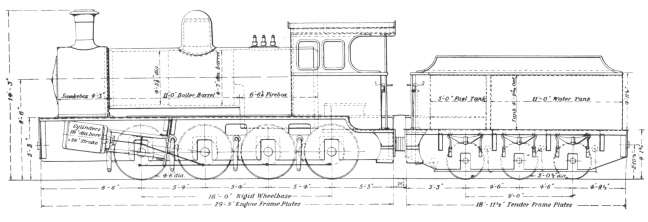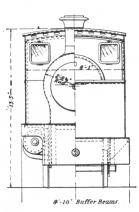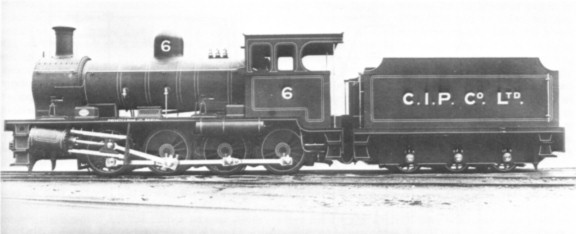
PECKETT & SONS LTD , 1824 of 1931
CHRISTMAS ISLAND PHOSPHATE CO LTD

| THE INDUSTRIAL RAILWAY RECORD |
© APRIL 1974 |
CHRISTMAS ISLAND PHOSPHATE CO LTD
NEW 0-8-0 PECKETT LOCOMOTIVE
|
|
|
|
|
"Situated about 160 miles south of Java Head, and 800 miles from Singapore, lies a lonely outpost of the British Empire, a luxuriant and picturesque island, first sighted by Captain Mynors on Christmas Day, 1643, while on a voyage from the East Indies, hence its name. It was not annexed to the British Empire until 1888, and is valuable by reason of its large deposits of phosphate of lime, now in demand as a fertiliser. To develop the phosphate, the Christmas Island Co. have installed up-to-date plant in the shape of crushers, drying kilns, wharves, etc., for shipping, and also a standard gauge railway, some eleven miles in length, for the transport of the phosphate from the quarry, now being worked, to the depot for handling, treatment, and shipment.
"The island rises to a height of some 1,170 ft. above sea level, and has such steep and precipitous sides that it was at first considered inaccessible. To‑day, however, the railway with which we are particularly interested runs round the hill sides at a level of about 700 ft. above the sea, and connects with the depot and wharves by a cable‑way incline, 3,500 ft. long, with a ruling grade of 1 in 6; the wire rope used on this has a length of 4,450 ft., and a circumference of 5 in. The worst curves on the main line of the railway, laid with 60‑lb. rails, are of 500 ft. radius, and the heaviest grades 1 in 100. Steel sleepers are used throughout.
"The rolling stock consists of five locomotives; of these, three, Nos.3, 4, and 5, are of the Shay geared type, 4‑4‑4, with drivers 3 ft. 0 in. dia., three inverted cylinders 12 in. by 15 in., and boilers with 900 sq. ft. of heating surface. These engines weigh 70 tons in running order, and have a tractive effort at 80% boiler pressure of 30,350 lb. The first of these was obtained from the Lima Locomotive Works, when the railway was constructed in 1914, as it was the original intention to work the trains direct to and from the high level main line and the sea level depot; the other two followed in subsequent years.
"Two small 0‑6‑0 tank engines, Nos.1 and 2, also by the Lima Works, are used for shunting service in the depot. These engines have cylinders 12 in. by 18 in. and drivers 3 ft. 3 in. dia.; the boiler pressure is 170 lb. per sq. in. and the tractive effort 9,856 lb.
"In order to speed up the transport from the quarry the directors have decided to augment the Shay locomotives with simple direct-driven machines. A new 0‑8‑0 type tender locomotive has, therefore, just been built by Messrs. Peckett & Sons Ltd., of Bristol. This engine, No.6, which we illustrate, has cylinders 18 in. by 26 in., and coupled drivers 4 ft. 6 in. dia. The boiler, lagged with Roberts' "Limpet" asbestos mattress, has 180 iron tubes, supplied by the Perfecta Seamless Steel Tube and Conduit Co., of 2 in. external diameter, and a total heating surface of 1,168 sq. ft.; feed is effected by two injectors and one pump. It carries a working pressure of 180 lb. per sq. in., and has a steel firebox, with a grate area equal to approximately 20 sq. ft. The tractive effort at 85% of the boiler pressure is 23,870 lb. The constructive details of this engine are simple and straightforward: Stephenson link motion, U.K. metallic packing to the piston rods and valve spindles, balanced regulator in the dome, all fittings harmonising with the particular work the locomotive is intended for. The weight in running order is 43 tons, equally distributed, whilst the six‑wheeled tender, carrying 2,500 gallons of water and 700 gallons of fuel oil, weighs 30 tons. The engine is equipped with the Westinghouse quick-acting continuous air brake, with which all the rolling stock is fitted, as well as a hand brake on both engine and tender. A Hasler tachometer is provided, so that accurate records can be secured of the runs made, speed maintained, etc. National frictional draft gear is also provided at front and rear.

Official photograph of Peckett 1824 of 1931, built for the Christmas Island Phosphate Co Ltd. (IRS Collection)
"Originally, wood fuel was used on the locomotives, but now oil fuel is being adopted, and No.6, the new engine, has been designed with a large firebox, and sent out fitted up in the most approved manner to burn this. The burner, operated by steam at from 25 to 30 lb. pressure, is of the "Mexican Trough" type, whilst the furnace in the firebox has been built from designs dictated by the best experience. Trials at the builders' works gave most successful results as regards control, steaming, etc. Steam is raised by a Kermode "lighter‑up," having its pump on the tender. To meet the conditions of a tropical climate the commodious cab has a teak lining under the steel roof with an air space between.
"The total wheelbase of the engine and tender is 36 ft. 4½ in. and total length over buffer beams 49 ft. 9¼ in. The trains hauled average about 600 tons behind the tender (16 steel hopper wagons of 15 tons tare and 22 tons load each), and these have been operated on a time-table of 2 hours per trip, with the Shay locomotives, allowing 20‑30 minutes on each journey for re‑fuelling with wood. With the new "direct" oil burning locomotive, the time is being cut to one hour as a start, and this will doubtless be reduced when the engine has been working for a time and the staff have become acquainted with the new procedure.
"In addition to the automatic air brake throughout the trains, all the stock is equipped with M.C.B. automatic central buffer couplers and friction draft-gear, so that safe operation can be depended upon with a minimum of staff. The water used for the boiler plant and the locomotives is treated at the depot, so that the steel fireboxes, tubes, and boilers in use are assured of a most satisfactory and long life. At the depot well equipped machine shops have been erected, so that maintenance, repairs, etc., are well provided for on the island. Electric power is generated by oil‑fired steam plant, Babcock boilers, and is distributed to all the different requirements from the central power station."
("The Locomotive Magazine," 15th May 1931. This solitary Peckett 0‑8‑0 locomotive, works number 1824 of Class OQT, was despatched on the 19th March 1931. Note the rather unusual touch of fitting three safety valves. - TJL)